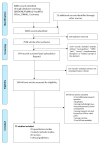Prevention and Treatment of Chemotherapy-Induced Peripheral Neuropathy (CIPN) with Non-Pharmacological Interventions: Clinical Recommendations from a Systematic Scoping Review and an Expert Consensus Process
- PMID: 36810482
- PMCID: PMC9944490
- DOI: 10.3390/medsci11010015
Prevention and Treatment of Chemotherapy-Induced Peripheral Neuropathy (CIPN) with Non-Pharmacological Interventions: Clinical Recommendations from a Systematic Scoping Review and an Expert Consensus Process
Abstract
Background: Most individuals affected by cancer who are treated with certain chemotherapies suffer of CIPN. Therefore, there is a high patient and provider interest in complementary non-pharmacological therapies, but its evidence base has not yet been clearly pointed out in the context of CIPN. Methods: The results of a scoping review overviewing the published clinical evidence on the application of complementary therapies for improving the complex CIPN symptomatology are synthesized with the recommendations of an expert consensus process aiming to draw attention to supportive strategies for CIPN. The scoping review, registered at PROSPERO 2020 (CRD 42020165851), followed the PRISMA-ScR and JBI guidelines. Relevant studies published in Pubmed/MEDLINE, PsycINFO, PEDro, Cochrane CENTRAL, and CINAHL between 2000 and 2021 were included. CASP was used to evaluate the methodologic quality of the studies. Results: Seventy-five studies with mixed study quality met the inclusion criteria. Manipulative therapies (including massage, reflexology, therapeutic touch), rhythmical embrocations, movement and mind-body therapies, acupuncture/acupressure, and TENS/Scrambler therapy were the most frequently analyzed in research and may be effective treatment options for CIPN. The expert panel approved 17 supportive interventions, most of them were phytotherapeutic interventions including external applications and cryotherapy, hydrotherapy, and tactile stimulation. More than two-thirds of the consented interventions were rated with moderate to high perceived clinical effectiveness in therapeutic use. Conclusions: The evidence of both the review and the expert panel supports a variety of complementary procedures regarding the supportive treatment of CIPN; however, the application on patients should be individually weighed in each case. Based on this meta-synthesis, interprofessional healthcare teams may open up a dialogue with patients interested in non-pharmacological treatment options to tailor complementary counselling and treatments to their needs.
Keywords: cancer; chemotherapy-induced peripheral neuropathy (CIPN); complementary therapies; consensus process; integrative oncology; interprofessional healthcare; non-pharmacological interventions; scoping review; supportive therapy.
Conflict of interest statement
The authors declare no conflict of interest.
Figures
References
-
- Hou S., Huh B., Kim H.K., Kim K.-H., Abdi S. Treatment of Chemotherapy-Induced Peripheral Neuropathy: Systematic Review and Recommendations. Pain Physician. 2018;21:571–592. - PubMed
-
- Molassiotis A., Cheng H.L., Lopez V., Au J.S.K., Chan A., Bandla A., Leung K.T., Li Y.C., Wong K.H., Suen L.K.P., et al. Are we mis-estimating chemotherapy-induced peripheral neuropathy? Analysis of assessment methodologies from a prospective, multinational, longitudinal cohort study of patients receiving neurotoxic chemotherapy. BMC Cancer. 2019;19:132. doi: 10.1186/s12885-019-5302-4. - DOI - PMC - PubMed
Publication types
MeSH terms
Substances
LinkOut - more resources
Full Text Sources
Medical
Miscellaneous




